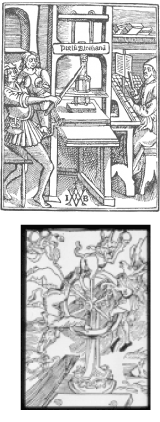Name
|
The InventionSection One In the Mid-15th Century, things begin to change in Europe with the advent of the printing press. In 1452, Gutenberg conceives of the idea for movable type. In his workshop, he brings together the technologies of paper, oil-based ink and the wine-press to print books. The printing press is not a single invention. It is the aggregation in one place, of technologies known for centuries before Gutenberg. His contribution to printing was the development of a punch and mold system which allowed the mass production of the movable type used to reproduce a page of text. These letters would be put together in a type tray which was then used to print a page of text. If a letter broke down, it could be replaced. When the printing of the copies of one page was finished, the type could be reused for the next page or the next book. Section Two By 1452, with the aid of borrowed money, Gutenberg began his famous Bible project. Two hundred copies of the two-volume Gutenberg Bible were printed, a small number of which were printed on vellum. The expensive and beautiful Bibles were completed and sold at the 1455 Frankfurt Book Fair, and cost the equivalent of three years' pay. After a short while new ideas started to spread faster than ever through new books on science, philosophy and religion. Gutenberg's printing technology spread rapidly throughout Europe and is considered a key to the Renaissance. Today, Gutenberg remains a towering figure in the popular image; in 1999, the A&E Cable Network ranked Gutenberg #1 on their "People of the Millennium" countdown and in 1997, Time–Life magazine picked Gutenberg's invention as the most important of the second millennium. |
|||||
|

